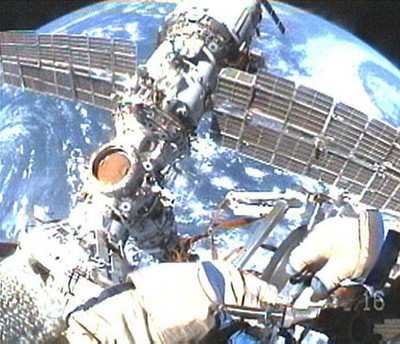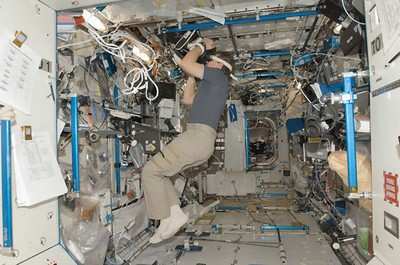Results From More Than 100 Experiments Detailed
 Advances in the fight against food poisoning, new methods for
delivering medicine to cancer cells, and better materials for
future spacecraft are among the results published in a NASA report
detailing scientific research accomplishments made aboard the
International Space Station during its first eight years.
Advances in the fight against food poisoning, new methods for
delivering medicine to cancer cells, and better materials for
future spacecraft are among the results published in a NASA report
detailing scientific research accomplishments made aboard the
International Space Station during its first eight years.
The report includes more than 100 science experiments ranging
from bone studies to materials' research.
"This report represents a record of science accomplishments
during assembly and summarizes peer-reviewed publications to date,"
said Julie Robinson, program scientist for the station at NASA's
Johnson Space Center in Houston. "As we enter the final year of
station assembly, this report highlights the capabilities and
opportunities for space station research after assembly is
complete."
One of the most compelling results reported is the confirmation
that the ability of common germs to cause disease increases during
spaceflight, but that changing the growth environment of the
bacteria can control this virulence. The Effect of Spaceflight on
Microbial Gene Expression and Virulence experiment identified
increased virulence of space-flown Salmonella typhimurium, a
leading cause of food poisoning. New research on subsequent station
missions will target development of a vaccine for this widespread
malady.

Another experiment produced a potential medical advance,
demonstrating a new and powerful method for delivering drugs to
targets in the human body. Microgravity research on the station was
vital to development of miniature, liquid-filled balloons the size
of blood cells that can deliver medicine directly to cancer cells.
The research was conducted for the Microencapsulation Electrostatic
Processing System experiment.
One of the most prolific series of investigations aboard the
station tests how spacecraft materials withstand the harsh space
environment. The results of the Materials International Space
Station Experiment already have been used to develop solar cells
for future commercial station cargo ships. This experiment has
significantly reduced the time needed to develop new satellite
systems, such as solar cells and insulation materials, and paved
the way for materials to be used in new NASA spacecraft such as the
Orion crew capsule.
The report compiles experiment results collected from the first
15 station missions, or expeditions, from 2000 to 2008. Results of
some of the summarized investigations are complete. Preliminary
results are available from other continuing investigations.
NASA's research activities on the station span several
scientific areas, including exploration technology development;
microgravity research in the physical and biological sciences;
human physiology research; Earth science and education.
The report details 22 different technology demonstrations; 33
physical science experiments; 27 biological experiments; 32
experiments focused on the human body; Earth observations and
educational activities. In addition to science important to
long-duration human spaceflights, most findings also offer new
understanding of methods or applications relevant to life on
Earth.

In 2008, station laboratory space and research facilities
tripled with the addition of the European Space Agency's Columbus
Laboratory and the Japan Aerospace Exploration Agency's three Kibo
scientific modules, adding to the capabilities already provided in
NASA's Destiny Laboratory. In 2009, the number of crew members
increased from three to six, greatly increasing crew time available
for research.
The stage is set for increased station scientific return when
assembly and outfitting of the research facility is completed in
2010 and its full potential as a national and international
laboratory is realized. Engineers and scientists from around the
world are working together to refine operational relationships and
build on experiences to ensure maximum use of the expanded
capabilities.
 Airborne-Flight Training 05.09.24: ERAU at AIAA, LIFT Diamond Buy, Epic A&P
Airborne-Flight Training 05.09.24: ERAU at AIAA, LIFT Diamond Buy, Epic A&P ANN's Daily Aero-Term (05.07.24): Hazardous Weather Information
ANN's Daily Aero-Term (05.07.24): Hazardous Weather Information Aero-News: Quote of the Day (05.07.24)
Aero-News: Quote of the Day (05.07.24) NTSB Final Report: Cessna 150
NTSB Final Report: Cessna 150 Aero-News: Quote of the Day (05.08.24)
Aero-News: Quote of the Day (05.08.24)





